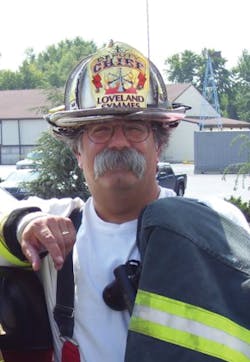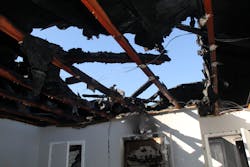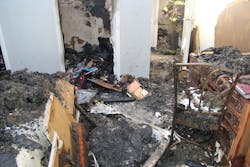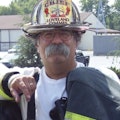Close Calls: A Saturated Ceiling, a Collapse & a Mayday
The fire service and professional football have similarities: a game plan (policies, procedures); training (on the policies and expected procedures); quarterbacks (good officers executing the plan with discretion); a coaching staff (incident command [IC] and division supervisors); and, most critically, well-trained, dedicated players who can count on leaders who do all that they can before and during the fray to push the team to a win and who take their role seriously.
We read, listen and talk about solid, no-nonsense leadership so often, but how often does it apply? Is it alive and well at most fire departments?
A few years ago, the chief of a suburban volunteer fire department made a sort of kidding promise to the chiefs of volunteer departments all over the county that he would have such a massive fire that he would call them on mutual aid someday. Much to that chief’s disappointment, that massive fire never occurred during his elected term.
A few days prior to that chief’s term expiring, his department was dispatched to a fire in a detached garage. The chief called in mutual aid, but not from neighboring departments—he called on two volunteer departments that were 22 miles and 17 miles away, respectively, to go right through the two dozen or so closer fire districts. Apparently, it was just for “the fun” of it.
Understandably, the county fire alarm dispatchers questioned an order for mutual aid from so far away. The chief apparently told them to just do as he said and to “get over it.”
What’s the point? Leadership. Calling in some “friends” miles and miles away for the fun of it? It’s a fireground, not a playground, and it survives or fails based on bosses doing what’s best for their troops, who can then take care of the people. What kind of decisions will be made when a genuine emergency occurs? What attitudes or personalities will come into play? Rest assured, those good or bad decisions will permeate everything.
The facts about maydays
Thanks to North American studies, such as by Chief Don Abbott (ret.), we in the fire service know more about what conditions result in a mayday and what actions most often lead to the successful rescue of firefighters.
Perhaps the most important facts that are uncovered by Chief Abbott’s “Project Mayday” plague both career and volunteer departments:
- No 360-degree size-up conducted.
- Crews wait too long to move to defensive operations from offensive.
- A substantial portion of maydays take place in vacant or abandoned buildings.
- ICs try to handle both the firefighting operations and the rescue.
- Firefighters change radio channels too often.
- Yelling/screaming over the radio.
- Many mayday victims express concerns after hearing who is coming to make the rescue (physical condition of rapid intervention team [RIT] member or general abilities).
Interestingly, none of those conditions occurred during the fire that is the incident that pertains to this month’s column. That said, a fire officer’s responsibility of being in command is a huge undertaking, and the people who run your companies, crews and scenes are the same people who will run your mayday. Related practical training must be initial and ongoing. Qualifications and experiences that your department demands assure that the public and your members have the best chance of survival.
In the following close call, the mayday was initiated at 11:59 a.m.; the firefighter was out at 12:04 p.m.; the mayday was secured at 12:11; and a total fireground personnel accountability report was completed at 12:13.
On Jan. 6, 2018, the Spartanburg, SC, Fire Department (SFD) responded to a call for a multifamily dwelling structure fire. Upon arrival, SFD Engine 64 (E64) began fighting the fire with automatic first alarm assistance from Hilltop Fire Department, North Spartanburg Fire Department, Roebuck Fire Department, Una Community Volunteer Fire Department and Westview-Fairforest Fire Department. During fire attack, a section of sheetrock ceiling fell on Lt. Ronald Hunter (along with Sgt. Kevin Tate), injuring Hunter. A mayday was called, and the RIT was deployed and assisted Tate to remove Hunter from the structure. Hunter was transported by EMS to the hospital.
Our sincere thanks to SFD Chief Marion Blackwell, his department, the dispatch center personnel, and all of the fire and EMS mutual aid partners who were involved. Special thanks to SFD Battalion Chief Doug Lea, Capt. Sammy Osment, Lt. Ron Hunter and Lt. Stephen Elder for their personal accounts of this incident.
The building
The 4,700-square-foot, two-story, eight-unit apartment building had a wood-pitched roof (prefabricated truss system with gusset plates). Wood construction was covered by a brick veneer on the exterior and sheetrock on the interior. The attic had a single fire separation in its center that ran from the Alpha side to the Charlie side; it was constructed of one layer of half-inch sheetrock on either side of the center truss. There were no sprinklers or common alarm systems.
Apartments were laid out with the kitchen and living room on the first floor and two bedrooms and a bath on the second floor.
The room in which Hunter was injured had a single layer of half-inch sheetrock applied to the ceiling.
E64 arrived on scene to find heavy smoke coming from the building. E64’s officer was met by a plumber, who stated that he was sweating pipes in a bathroom when he accidentally ignited insulation.
Fire crews advanced a 1¾-inch handline into the front door and up to the second floor, where they encountered heavy smoke down to the floor. Crews pulled ceiling in the bathroom and attacked the fire, only to find that the fire spread into the attic space.
Account from Sgt. Kevin Tate
After arriving on scene (with smoke showing from the roof), Rescue 60 (R60) began a primary search on several apartments. Once that was completed, R60 began to help E64 to pull the ceiling in the apartment that was involved. E64 had a lot of fire in the attic, so R60 hooked the ceiling in the back bedroom, so water could be put on the fire. E64 had a low-air alarm go off, so they exited; R60 continued with fire attack. R60 found heavy fire in the front bedroom in the wall and closet and relocated the hose to the front bedroom and started to put water on the fire.
While putting water on the fire, the ceiling in the bedroom turned loose and fell on both Hunter and me. The ceiling knocked me down to one knee and knocked Hunter unconscious. I called for Hunter several times and moved closer and found him lying on his stomach unresponsive. I tried to get some kind of response from Hunter but was unable to get any. I called a mayday and gave what info I could; then I sat Hunter up against a wall. At this point, Hunter began to give some audible responses, so I asked him whether he was hurt and whether he could walk. He replied that he was able to walk if I helped him up, so I did; by that time, the RIT was entering the room, and we all exited the structure. Once outside, the medics began to work on Hunter. He then was transported to the hospital.
The crew was operating in a room in which fire streams had been applied above the ceiling. Water saturated the sheetrock. Additionally, the significant fire above the apartment might have weakened the ceiling. It was reported that the entire bedroom ceiling failed catastrophically and simultaneously.
This incident didn’t worsen to something beyond a close call, because the SFD and their mutual aid partners work hard to ensure a coordinated operating effort, including common terminology, operations and radio communications. Numerous things went well during the incident: Command was established from the start, and a clear understanding of the tactical plan (offensive fire) was known. All members were on air and were in full PPE.
That said, the SFD took away a variety of facets that it found could be improved:
- Awareness of surroundings and conditions. Actions by other crews, even previous actions, can affect the stability of a structure. In this case, fire streams were applied to the attic area above the fire crew. This caused the sheetrock to fall. This action was predictable, if not readily apparent. Ideally, if the ceiling was removed starting from the doorway entering the room, Hunter’s injury likely could have been avoided. However, because of the discovery of fire in the closet and subsequent actions to suppress it, removing the ceiling might not have been practical in the moment.
- Size-up: Although the SFD provides much training in conducting size-ups when arriving at an incident, additional training could focus on interior size-up and predicting building behavior based on the fire’s destructive action and firefighters’ actions.
- Division/group assignments. Assignments for officers and their crews should be more clearly identified. When multiple companies operate on a division, assign a chief (rather than a company officer) to coordinate operations and tasks.
- Discipline. Tighten up accountability, so command clearly understands where companies are and what they are doing at all times.
- Coordination. Assign the secondary truck company to coordinate with the first to ensure that all truck company duties are completed.
- First-alarm chiefs. Ensure that enough chiefs are on the first alarm to allow for divisional assignments and command support (rather than assigning those to working company officers) and span of control. This incident and a couple of others initiated the formation of the County Command Team. A call of this type now gets three or four additional chief officers on the initial dispatch.
- Mayday. Ensure that all fireground units and dispatch are aware of the mayday and understand what to do—and what not to do. Stay focused on your task unless otherwise directed.
- RIT preparedness. The RIT must be focused, fully staffed, and ready to go with all tools and equipment. Throw ground ladders to any and all potential access/egress areas.
- RIT’s 360. The RIT must conduct a 360-degree size-up, including familiarization of the incident and structure and secondary means of access.
- Automatic dispatching. Dispatching of additional companies by the communication center should be automatic when a mayday is declared. Also, during the period of time that was associated with the mayday, the dispatcher requested a move to another channel. Although the request was refused, it caused a delay in getting the only additional engine company and battalion chief to the mayday. (The current county standard operating procedure is to dispatch two engine companies anytime that a mayday is declared.)
- Train to communicate. Radio discipline during a fire as well as a mayday will come with more scenario-based training.
- Staging. Designate a staging area (Level 1 and Level 2) for additional units as they arrive.
Comments from Chief Goldfeder
Overall, the incident went well. The fire was held, and there were no critical injuries. Take particular note in the heavy first-alarm assignment, regardless of jurisdictional lines. Does this fall into the realm of good customer service? Sure, but more critically, that heavy response provides enough personnel to perform the many predictable and numerous tasks simultaneously.
Although all of the crews performed to the best of their abilities and operated in the most effective and safe way as possible, there always is room for improvement, as the SFD has genuinely shared with us all.
Although it’s easy to focus on this fire and the SFD, the real intent of this column is to take its information and apply it to your fire department, so history isn’t repeated. There is no question that the leadership of the SFD and their mutual aid partners understood before—and after—this fire that it’s a fireground, not a playground. They definitely know that future performance must be set by the bosses—the chiefs and the officers—doing what’s best for their troop—their firefighters—who can then take care of the people.
About the Author
Billy Goldfeder
BILLY GOLDFEDER, EFO, who is a Firehouse contributing editor, has been a firefighter since 1973 and a chief officer since 1982. He is deputy fire chief of the Loveland-Symmes Fire Department in Ohio, which is an ISO Class 1, CPSE and CAAS-accredited department. Goldfeder has served on numerous NFPA and International Association of Fire Chiefs (IAFC) committees. He is on the board of directors of the IAFC Safety, Health and Survival Section and the National Fallen Firefighters Foundation.



